2000 HONDA ODYSSEY lock
[x] Cancel search: lockPage 8 of 352
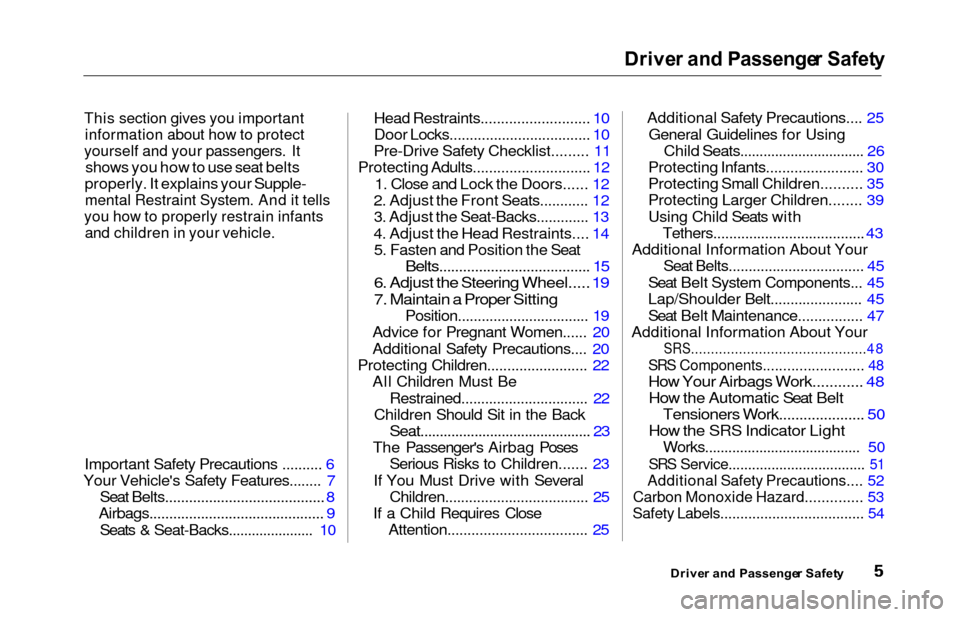
Driver an d Passenge r Safet y
This sectio
n gives you important
information about how to protect
yourself and your passengers. It
shows you how to use seat belts
properly. It explains your Supple-
mental Restraint System. And it tells
you how to properly restrain infants
and children in your vehicle.
Important Safety Precautions ..........
6
Your Vehicle'
s Safety Features........
7
Seat
Belts.......................................
.
8
Airbags............................................
9
Seat
s & Seat-Backs......................
10
Head
Restraints..........................
. 10
Door Locks................................... 10
Pre-Drive Safety Checklist......... 11
Protecting Adults............................. 12
1. Close and Lock the Doors...... 12
2. Adjust the Front Seats............ 12 3. Adjust the Seat-Backs............. 13
4. Adjust the Head Restraints.... 14 5. Fasten and Position the Seat
Belts...................................... 15
6. Adjust the Steering Wheel.....
19
7. Maintai
n a Proper Sitting
Position................................. 19
Advice for Pregnant Women...... 20
Additional Safety Precautions.... 20
Protecting Children......................... 22 All Children Must Be
Restrained................................ 22
Children Should Sit in the Back
Seat............................................ 23
The Passenger's Airbag Poses Serious Risks to Children....... 23
If You Must Drive with Several Children.................................... 25
If a Child Requires Close Attention................................... 25 Additional Safety Precautions.... 25
General Guidelines for Using Child Seats................................ 26
Protecting Infants........................ 30
Protecting Small Children.......... 35
Protecting Larger Children........ 39
Using Child Seats with Tethers......................................
43
Additional Informatio
n About Your
Seat Belts.................................. 45
Seat Belt System Components... 45
Lap/Shoulder Belt....................... 45
Seat Belt Maintenance................ 47
Additional Information About Your
SRS............................................
48
SRS Components........................
.
48
How
You
r Airbags Work............ 48
How the Automatic Seat Belt
Tensioners Work..................... 50
How the SRS Indicator Light
Works........................................ 50
SRS Service...................................
51
Additional Safet
y Precautions.... 52
Carbon Monoxide Hazard.............. 53
Safety Labels.................................... 54
Driver an d Passenge r Safet y
Page 10 of 352
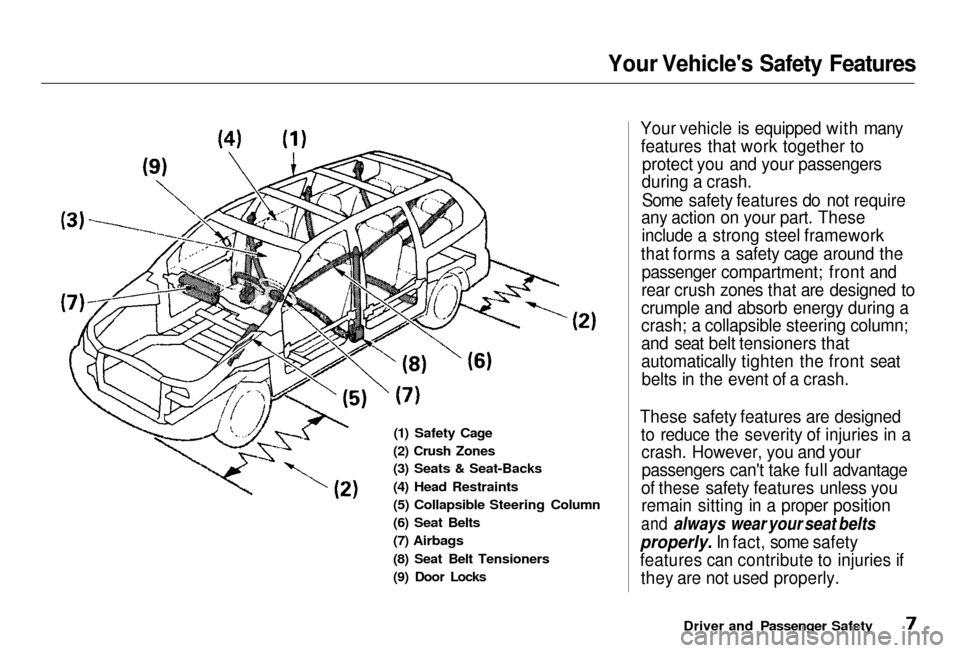
Your Vehicle's Safety Features
(1) Safety Cage
(2) Crush Zones
(3
) Seats & Seat-Backs
(4) Head Restraints
(5)
Collapsible Steering Column
(6) Seat Belts
(7)
Airbags
(8)
Seat Belt Tensioners
(9)
Door Locks
Your vehicle is equipped with many
features that work together to protect
you and your passengers
during a crash.
Some safety features do not require
any action on your part. These
include
a strong steel framework
that
forms a safety cage around the
passenger
compartment; front and
rear crush zones that are designed to
crumple and absorb energy during a
crash;
a collapsible steering column;
and seat belt tensioners that
automatically tighten the front seat belts in the event of a crash.
These safety features are designed to reduce the severity of injuries in acrash.
However, you and your
passengers
can't take full advantage
of these safety features unless you
remain
sitting in a proper position
and always wear your seat belts
properly. I
n fact, some safety
features can contribute to injuries if they
are not used properly.
Driver and Passenger Safety
Page 13 of 352
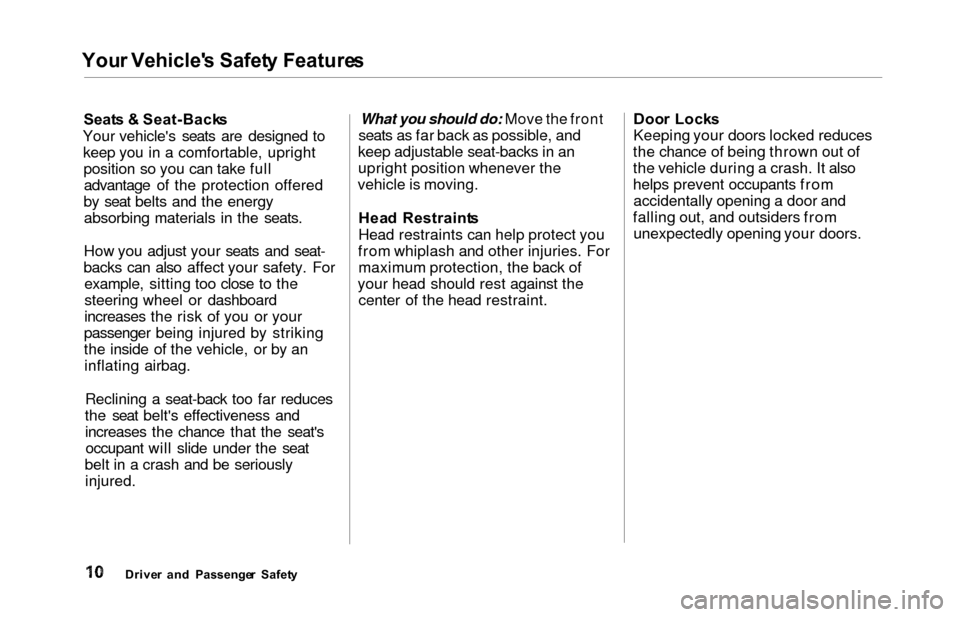
Your Vehicle' s Safet y Feature s
Seats & Seat-Back s
Your vehicle's seats are designed to keep you in a comfortable, uprightposition so you can take fulladvantage of the protection offered
by seat belts and the energy absorbing materials in the seats.
How you adjust your seats and seat-
backs can also affect your safety. For example, sitting too close to the
steering wheel or dashboard
increases the risk of you or your
passenger being injured by striking
the inside of the vehicle, or by an inflating airbag.
Reclining a seat-back too far reduces
the seat belt's effectiveness and increases the chance that the seat'soccupant will slide under the seat
belt in a crash and be seriously injured.What you should do: Move the front
seats as far back as possible, and
keep adjustable seat-backs in an
upright position whenever the
vehicle is moving.
Hea d Restraint s
Head restraints can help protect you
from whiplash and other injuries. For maximum protection, the back of
your head should rest against the center of the head restraint. Doo
r Lock s
Keeping your doors locked reduces
the chance of being thrown out of
the vehicle during a crash. It also
helps prevent occupants from accidentally opening a door and
falling out, and outsiders from unexpectedly opening your doors.
Drive r an d Passenge r Safet y
Page 14 of 352
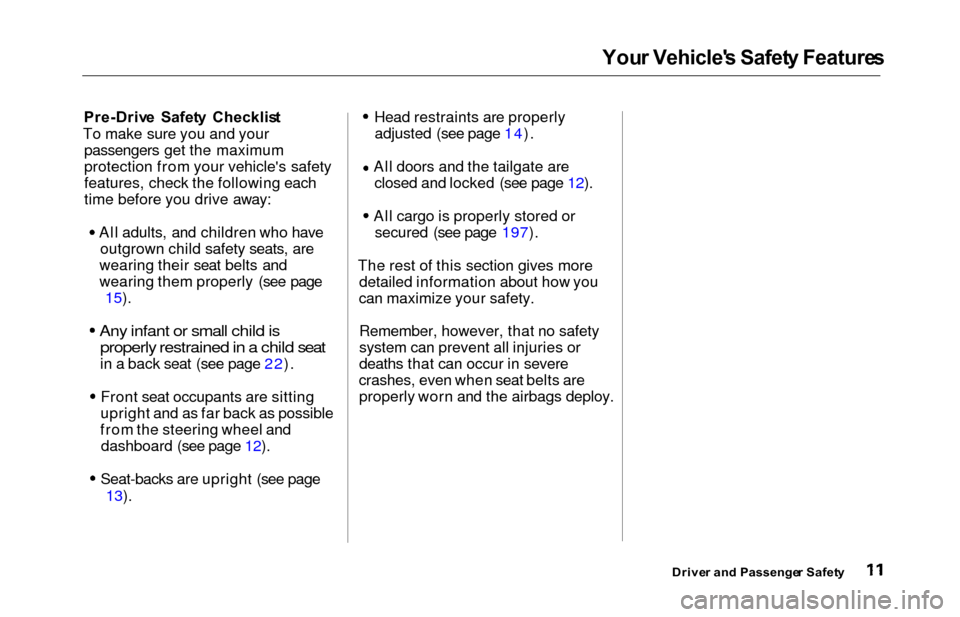
You
r Vehicle' s Safet y Feature s
Pre-Driv e Safet y Checklis t
To make sure you and your passengers get the maximum
protection from your vehicle's safety
features, check the following each
time before you drive away: All adults, and children who have
outgrown child safety seats, are
wearing their seat belts and
wearing them properly (see page 15).
Any infant or small child is
properly restrained in a child seat
in a back seat (see page 22). Front seat occupants are sitting
upright and as far back as possible
from the steering wheel and dashboard (see page 12). Seat-backs are upright (see page
13). Head restraints are properly
adjusted (see page 14). All doors and the tailgate are
closed and locked (see page 12). All cargo is properly stored or
secured (see page 197).
The rest of this section gives more detailed information about how you
can maximize your safety.
Remember, however, that no safety
system can prevent all injuries or
deaths that can occur in severe
crashes, even when seat belts are properly worn and the airbags deploy.
Driver an d Passenge r Safet y
Page 15 of 352
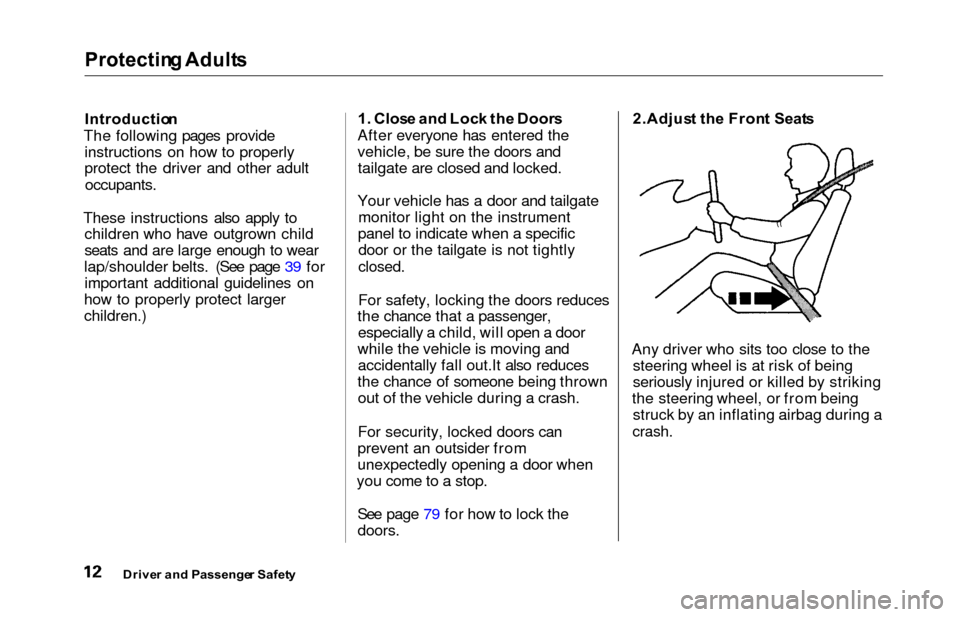
Protecting Adult s
Introductio n
The following pages provide instructions on how to properly
protect the driver and other adult
occupants.
These instructions also apply to children who have outgrown child
seats and are large enough to wear
lap/shoulder belts. (See page 39 for important additional guidelines on
how to properly protect larger
children.) 1
. Clos e an d Loc k th e Door s
After everyone has entered the
vehicle, be sure the doors and tailgate are closed and locked.
Your vehicle has a door and tailgate monitor light on the instrument
panel to indicate when a specific door or the tailgate is not tightly
closed.
For safety, locking the doors reduces
the chance that a passenger, especially a child, will open a door
while the vehicle is moving and accidentally fall out.It also reduces
the chance of someone being thrown out of the vehicle during a crash.
For security, locked doors can
prevent an outsider from
unexpectedly opening a door when
you come to a stop.
See page 79 for how to lock the
doors. 2.Adjus
t th e Fron t Seat s
Any driver who sits too close to the steering wheel is at risk of being
seriously injured or killed by striking
the steering wheel, or from being struck by an inflating airbag during a
crash.
Drive r an d Passenge r Safet y
Page 16 of 352
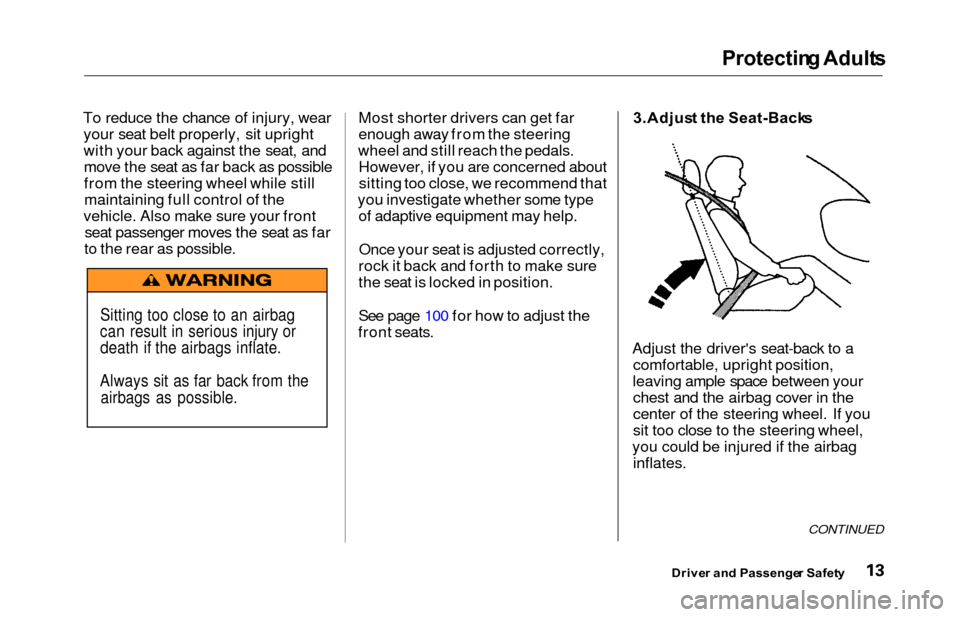
Protecting Adult s
To reduce the chance of injury, wear
your seat belt properly, sit upright
with your back against the seat, andmove the seat as far back as possible
from the steering wheel while stillmaintaining full control of the
vehicle. Also make sure your front seat passenger moves the seat as far
to the rear as possible. Most shorter drivers can get far
enough away from the steering
wheel and still reach the pedals. However, if you are concerned aboutsitting too close, we recommend that
you investigate whether some type of adaptive equipment may help.
Once your seat is adjusted correctly,
rock it back and forth to make sure
the seat is locked in position.
See page 100 for how to adjust the
front seats. 3.Adjus
t th e Seat-Back s
Adjust the driver's seat-back to a comfortable, upright position,
leaving ample space between your chest and the airbag cover in the
center of the steering wheel. If you
sit too close to the steering wheel,
you could be injured if the airbag inflates.
CONTINUED
Drive r an d Passenge r Safet y
Sitting too close to an airbag
can result in serious injury or death if the airbags inflate.
Always sit as far back from the airbags as possible.
Page 23 of 352
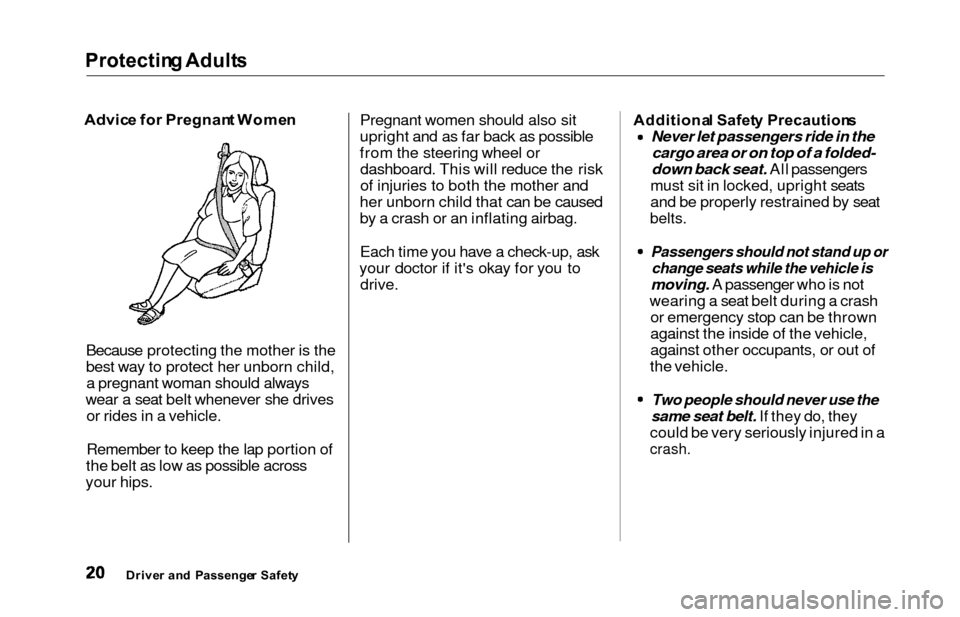
Protecting Adult s
Advice fo r Pregnan t Wome n
Because protecting the mother is the
best way to protect her unborn child, a pregnant woman should always
wear a seat belt whenever she drives or rides in a vehicle.
Remember to keep the lap portion of
the belt as low as possible across
your hips. Pregnant women should also sit
upright and as far back as possible
from the steering wheel or dashboard. This will reduce the risk
of injuries to both the mother and
her unborn child that can be caused
by a crash or an inflating airbag.
Each time you have a check-up, ask
your doctor if it's okay for you to drive.Additiona l Safet y Precaution s
Never let passengers ride in the
cargo area or on top of a folded-
down back seat. All passengers
must sit in locked, upright seats
and be properly restrained by seat
belts.
Passengers should not stand up or
change seats while the vehicle is
moving. A passenger who is not
wearing a seat belt during a crash or emergency stop can be thrown
against the inside of the vehicle,
against other occupants, or out of
the vehicle.
Two people should never use the
same seat belt. If they do, they
could be very seriously injured in a
crash.
Drive r an d Passenge r Safet y
Page 28 of 352
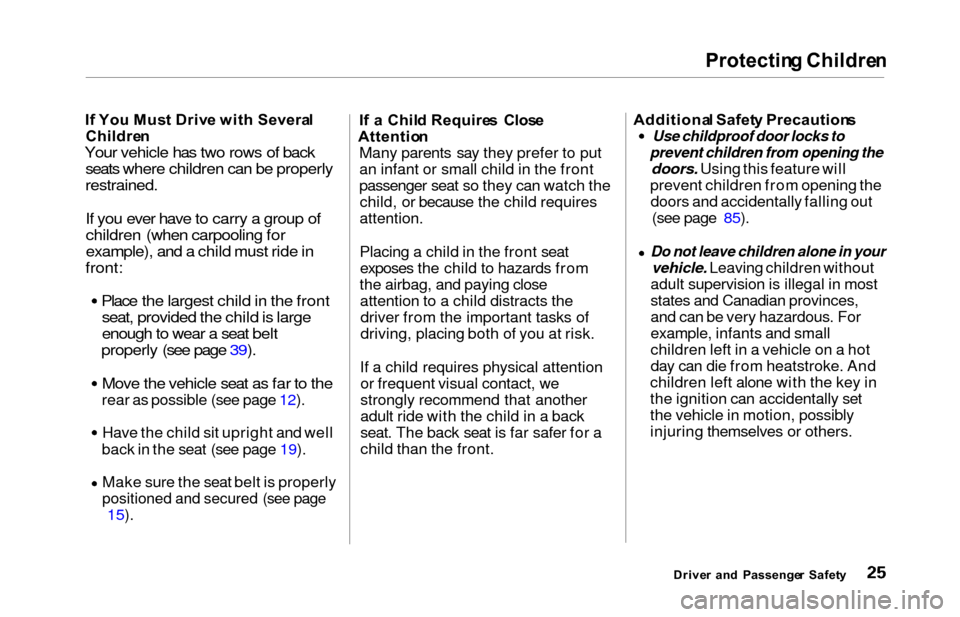
Protecting Childre n
If Yo u Mus t Driv e wit h Severa l
Childre n
Your vehicle has two rows of back
seats where children can be properly
restrained.
If you ever have to carry a group ofchildren (when carpooling for
example), and a child must ride in
front:
Place the largest child in the frontseat, provided the child is large
enough to wear a seat belt
properly (see page 39).
Move the vehicle seat as far to the
rear as possible (see page 12). Have the child sit upright and well
back in the seat (see page 19).
Make sure the seat belt is properly
positioned and secured (see page
15). I
f a Chil d Require s Clos e
Attentio n
Many parents say they prefer to put
an infant or small child in the front
passenger seat so they can watch the child, or because the child requires
attention.
Placing a child in the front seatexposes the child to hazards from
the airbag, and paying close attention to a child distracts thedriver from the important tasks of
driving, placing both of you at risk.
If a child requires physical attention or frequent visual contact, we
strongly recommend that another
adult ride with the child in a back
seat. The back seat is far safer for a
child than the front. Additiona
l Safet y Precaution s
Use childproof door locks to
prevent children from opening the
doors. Using this feature will
prevent children from opening the doors and accidentally falling out (see page 85).
Do not leave children alone in your
vehicle. Leaving children without
adult supervision is illegal in most
states and Canadian provinces,
and can be very hazardous. For
example, infants and small
children left in a vehicle on a hot
day can die from heatstroke. And
children left alone with the key in
the ignition can accidentally set
the vehicle in motion, possibly
injuring themselves or others.
Drive r an d Passenge r Safet y